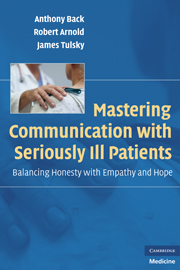Book contents
- Frontmatter
- Contents
- PREFACE
- 1 TAKING YOUR SKILLS TO THE NEXT LEVEL
- 2 GETTING A GOOD START
- 3 TALKING ABOUT SERIOUS NEWS
- 4 DISCUSSING EVIDENCE FOR MAKING TREATMENT DECISIONS
- 5 DISCUSSING PROGNOSIS
- 6 BETWEEN THE BIG EVENTS
- 7 CONDUCTING A FAMILY CONFERENCE
- 8 DEALING WITH CONFLICTS
- 9 TRANSITIONS TO END-OF-LIFE CARE
- 10 TALKING ABOUT DYING
- 11 CULTIVATING YOUR SKILLS
- APPENDIX A THE ROADMAPS IN OUTLINE FORM
- APPENDIX B ACKNOWLEDGMENTS
- INDEX
7 - CONDUCTING A FAMILY CONFERENCE
With a group, you multitask
Published online by Cambridge University Press: 23 November 2009
- Frontmatter
- Contents
- PREFACE
- 1 TAKING YOUR SKILLS TO THE NEXT LEVEL
- 2 GETTING A GOOD START
- 3 TALKING ABOUT SERIOUS NEWS
- 4 DISCUSSING EVIDENCE FOR MAKING TREATMENT DECISIONS
- 5 DISCUSSING PROGNOSIS
- 6 BETWEEN THE BIG EVENTS
- 7 CONDUCTING A FAMILY CONFERENCE
- 8 DEALING WITH CONFLICTS
- 9 TRANSITIONS TO END-OF-LIFE CARE
- 10 TALKING ABOUT DYING
- 11 CULTIVATING YOUR SKILLS
- APPENDIX A THE ROADMAPS IN OUTLINE FORM
- APPENDIX B ACKNOWLEDGMENTS
- INDEX
Summary
When does a family conference make a difference?
How you deal with a patient's family can make or break the relationship you have with the patient. Plus, the family can help you: they can repeat things, reinforce your message, clue you in on what's important. In the process, they will be better at the caregiving they take on, cope better, and will feel more rewarded for their efforts.
At the right moment, getting the whole family (and the patient if possible) into a room can be hugely beneficial. Most often this happens in the hospital, but this is a tool you can use also in an outpatient clinic. However family conferences take time, effort, and a lot of people, and research in this area doesn't tell us when the effort and expense required for a family conference actually pay off. So, when are they worthwhile? One trigger for a family conference is when there is serious news to discuss (e.g., the goals of treatment need to change from curative to palliative) and the patient wants to have the family involved, or the patient is too ill to participate. Another trigger is when the patient is too ill to participate in decision making, and the family members disagree about the decisions that need to be made.
We are not saying that you should talk with family members only in these situations.
- Type
- Chapter
- Information
- Mastering Communication with Seriously Ill PatientsBalancing Honesty with Empathy and Hope, pp. 79 - 92Publisher: Cambridge University PressPrint publication year: 2009



